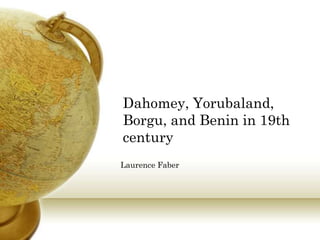
african powerpoint
- 1. Dahomey, Yorubaland, Borgu, and Benin in 19th century Laurence Faber
- 2. Mono-Niger Area • The region bounded in the west by the Mono river • In the east and the north by the Niger • In the south by the Bight of Benin (Atlantic Ocean) • Undulating plain with a rise from the coast towards the interior • Dense rain forest to the south-east
- 3. Four main distinct areas
- 4. The Aja Area • Aja speaking people are divided into three subgroups • Fon – dominated ancient kingdom of Dahomey • Gun – of the Weme river valley • Ewe – inhabited between the Cufo and Mono rivers
- 5. The Yoruba Area • Most extensive of the three groups • Covers the present-day Ogun, Lagos Oyo, and Ondo states of Nigera and nearly half of Kwara State, as well as the adjacent parts of the eastern Benin Republic and central Togo. • Numerous sub-groups • Oyo (most numerous) • Ibarapa • Ife and Ijesa • Ijebu • Many more
- 6. The Borgu Area • Situated mostly in present- day Borgu of Kwara and Sokoto state of Nigera • Largest state of Borgu is now split into Benin and Nigerian areas • Busa, Nikki, and Illo were the main power center • Two major languages spoken: • Batonu and Boku • Cultural unity through bilingualism
- 7. The Edo Area • Edo speaking people of the Benin kingdom • Linguistically and historically related areas situated all around. • These four zones were not isolated. It has been said that all four groups can be described as sub systems of one culture. These linkages point to successive migrations and population movements and counter-movements which continued into the 19th century until formally discouraged by the establishment of territorially structured European colonial states.
- 8. Collapse of Old Oyo • Old Oyo was the most important single power in the mono-niger region in 1800. • Attacked numerous groups in the area. • Used cavalry to their advantage in the parts not covered by rainforest • Benin and Oyo kingdom claim the same founder, Oranyan.
- 9. Collapse of the Oyo empire • The collapse of the Oyo empire brought massive change because of the scale of the influence they had over the surrounding groups. • This marked a continuous period of warfare and insecurity in the region • These conditions made it easy for European countries to take advantage of the unruly atmosphere
- 10. The collapse of Oyo cont’d. • The Oyo empire had already begun to show signs of deterioration militarily and territorially. • The rebellion which the Egba staged under Lisabi, their legendary hero, followed with the defeat of the Oyo in 1774. Two other defeats occurred in 1783 and 1791 by the Borgu and Nupe. • Final collapse of the empire in 1835.
- 11. Muslims take control • The muslims took control of the area when Alimi, a Fulbe muslim teacher, obtained the blessing of the Sokoto Caliphate and became the first Amir of Ilorin.
- 12. Jihad spreads across the Mono-Niger • Jihad of Fodio spread in all directions, including Borgu and Yoruba. • Also raids in Egbado by the Fulbe jihad. • The Borgu and Oyo alliance failed to confront the jihad of the Fulbe in 1836 and they lost. • Although, more devastating were the fights the Yoruba fought amongst themselves in the Owu War of 1820-1825, the Ijaye War of 1860- 1865, and the Ekitiparapo War of 1877-1893.
- 13. Rise of Dahomey Kingdom • Because of the fall of the Old Oyo Kingdom, Dahomey rose as an autonomous kingdom in the early 1820s up until the French conquest of 1892. • It was the policy of all Dahomey monarchs to keep independence from Oyo, but not until the reign of Gezo that the Oyo imperial yoke was fully repudiated.
- 14. Dahomey Kingdom cont’d • Political stability was further guaranteed by the successful operation of the highly centralized administration for which the kingdom is well known. The European anti-slave trade movement hit the state's economy, based as it was almost solely on the slave trade. However, Gezo's economic policy was to continue to respond to the demand for slaves from Portuguese dealers while at the same time responding to the stimulus of the export trade in palm oil as the ultimate substitute for slave exports.
- 15. Dahomey Kingdom cont’d • Dahomey’s need for crops and more prisoners to draw into the slave trade brought them to invade Yorubaland in the 1820s • Although, the Dahomey kingdom slowly started to crumble in the late 1800s because of these clashes against neighboring groups.
- 16. Effects of the activiy in the Mono-Niger • Far reaching population shifts • Massive enslavement and shipment of Yoruba and Aja populations to the Americas and Sierra Leone • Large scale destruction of pre 19th century settlements in Yorubaland • Movement in population from the troubled north towards the south • New forms of government